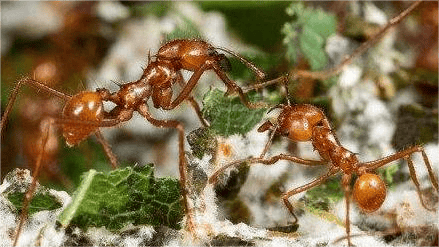Deep within the lush forests of Central and South America exists one of nature’s most sophisticated farming systems, operated not by humans but by tiny insects. Leafcutter ants, belonging to the tribes Attini and Atta, have been practicing agriculture for over 50 million years—long before humans conceived of farming. These remarkable creatures have evolved a complex symbiotic relationship with a specific type of fungus that serves as their primary food source. Unlike most ants that forage for food, leafcutters cultivate their own nourishment in elaborate underground chambers, demonstrating one of the most advanced agricultural systems in the animal kingdom.
What makes this relationship truly extraordinary is the level of sophistication involved. Leafcutter colonies, which can contain up to 8 million individuals, function like well-organized agricultural societies with distinct castes performing specialized roles. From the smallest workers that tend the fungal gardens to the largest soldiers that defend the colony, each ant contributes to the farming operation that sustains their massive communities. This ancient partnership between ant and fungus represents one of evolution’s most successful experiments in mutualism, allowing these insects to dominate their ecosystems and become one of the most ecologically important species in Neotropical forests.
The Evolution of Ant Agriculture
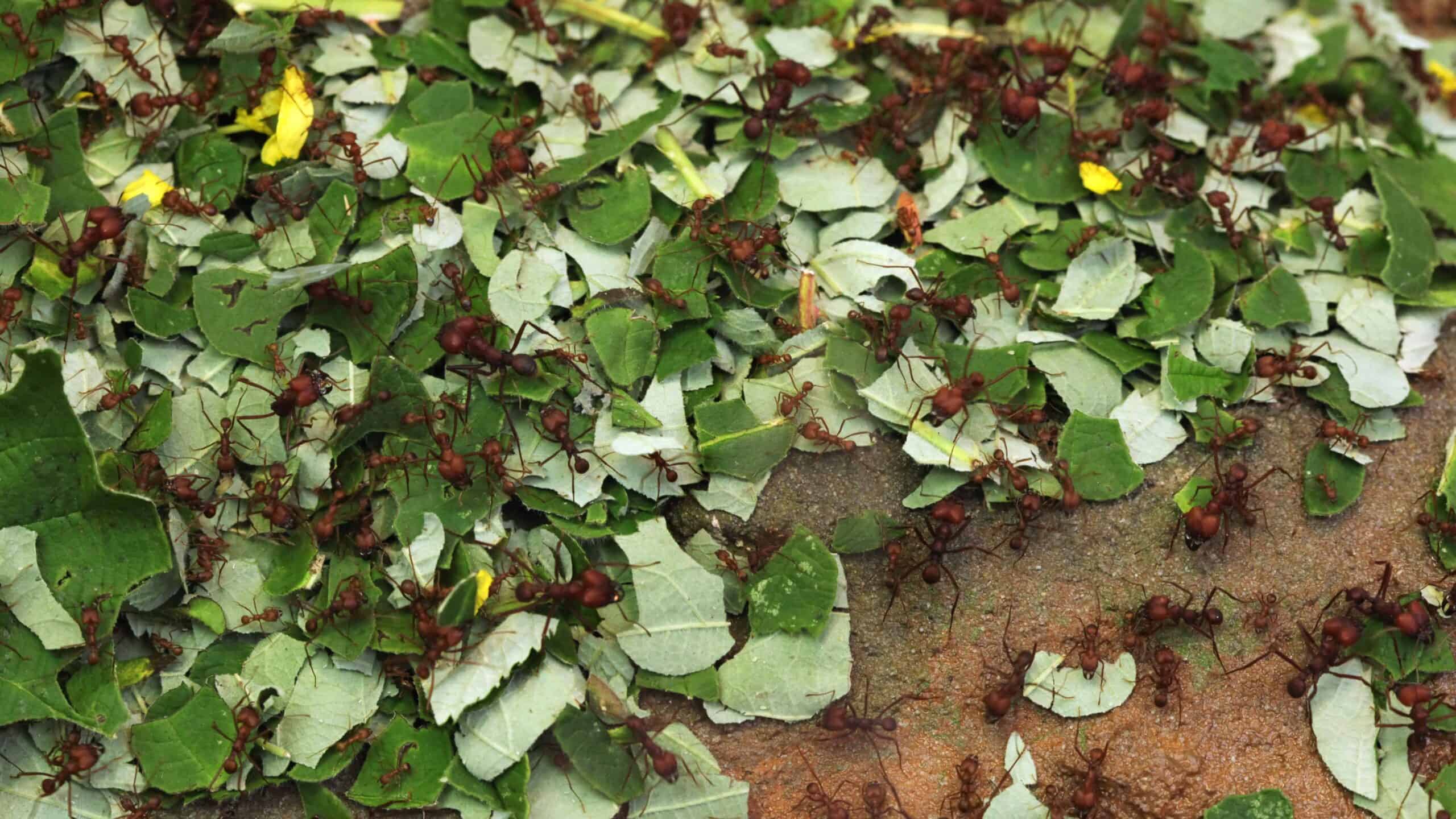
The agricultural relationship between leafcutter ants and their fungal crops didn’t develop overnight. Evolutionary biologists have traced the origins of this symbiosis back approximately 50-60 million years, making it one of the oldest known examples of agriculture on Earth. The relationship began when ancient ant species started cultivating wild fungi that grew on their waste. Over millions of years, both the ants and their fungal partners evolved increasingly specialized adaptations that enhanced their mutual benefits. This co-evolution resulted in the ants developing specialized morphological features and behaviors for harvesting plant material, while the fungi evolved to become entirely dependent on the ants for survival.
Remarkably, different lineages of fungus-growing ants represent various stages in the evolution of agricultural practices. The most primitive fungus-farmers cultivate fungi that can still survive in the wild, while more advanced species like leafcutters cultivate highly domesticated fungal strains that exist nowhere else in nature. These domesticated fungi have lost the ability to produce the enzymes needed to break down plant material on their own and now rely entirely on the ants’ processing of leaves. This parallel with human agricultural development is striking—just as humans have domesticated crops to the point where many cannot survive without human intervention, leafcutter ants have created fungal varieties that exist solely within their carefully maintained gardens.
The Species-Specific Fungal Partnership

At the heart of the leafcutter ant’s agricultural system is a specific genus of fungus called Leucoagaricus, belonging to the same family as button mushrooms. However, unlike their mushroom relatives found in grocery stores, the Leucoagaricus species cultivated by leafcutter ants are highly specialized. Each species of leafcutter ant typically cultivates its own specific strain of fungus, with the relationship so intimate that neither partner can survive without the other. The fungus provides the ants with essential nutrients, particularly proteins and carbohydrates, while the ants provide the fungus with ideal growing conditions, protection from competitors, and a constant supply of plant material.
What’s particularly fascinating about this relationship is that the fungus cultivated by leafcutters produces specialized structures called gongylidia—nutrient-rich swellings that grow nowhere else in nature except in ant gardens. These structures, which resemble small white bulbs, are specifically designed to feed the ants, containing high concentrations of lipids, carbohydrates, and proteins. Essentially, the fungus has evolved its own specialized “fruits” that make it easier for the ants to harvest nutrients, demonstrating how this symbiotic relationship has shaped both species over millions of years of co-evolution. This level of mutual adaptation represents one of the most remarkable examples of co-evolution in the natural world.
The Complex Architecture of Underground Fungus Gardens
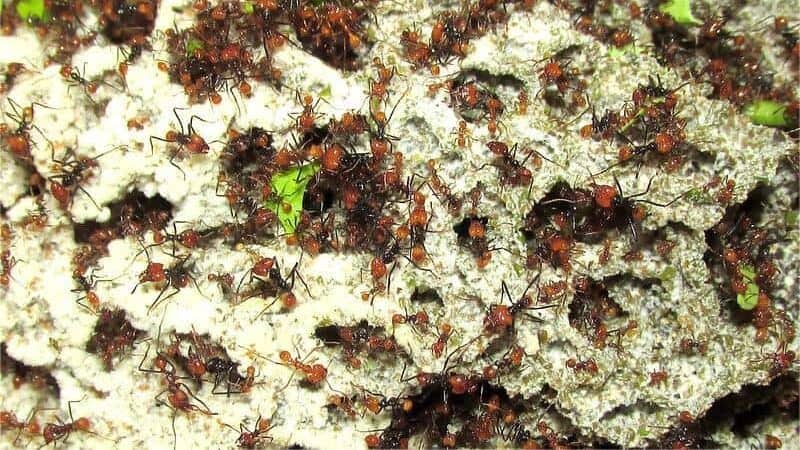
Leafcutter ant colonies construct elaborate underground chambers specifically designed for fungus cultivation. These chambers, often referred to as “gardens,” can extend several meters below the surface and span many square meters in total area. A mature colony may contain hundreds of these fungal chambers, each carefully maintained at optimal temperature and humidity levels. The architectural sophistication of these structures is remarkable—ants create ventilation tunnels to regulate airflow, drainage systems to manage moisture, and even construct different chambers for different stages of fungal growth. This environmental engineering creates perfect microhabitats where the fungus can thrive.
The physical structure of the gardens themselves is equally impressive. Within each chamber, the ants construct a sponge-like matrix composed of chewed leaf material and fungal hyphae. This three-dimensional structure maximizes the surface area available for fungal growth while allowing easy access for worker ants to tend the garden. The gardens are typically arranged in layers, with newer leaf material added to the top and older, processed material removed from the bottom. This continuous cycle of addition and removal keeps the garden productive and healthy. Some species even create specialized waste chambers located far from the fungal gardens to prevent contamination, demonstrating an intuitive understanding of waste management that rivals human agricultural practices.
The Leaf-Harvesting Process

The iconic image of leafcutter ants—tiny creatures carrying leaf fragments many times their size—represents just the beginning of a sophisticated agricultural process. These ants are remarkably selective in their harvesting, choosing specific plant species and even particular leaves based on their chemical composition and nutritional value for their fungal crop. When a suitable leaf is located, specialized cutter ants use their powerful mandibles to slice through the leaf material with surgical precision, cutting out semicircular sections. These sections are then passed to carrier ants who transport them back to the nest, forming the characteristic “ant highways” that can stretch for over 100 meters from the colony to harvesting sites.
The harvesting operation is remarkably efficient, with different castes of ants performing specialized roles. The largest workers, called majors, serve as defenders against threats like army ants or parasitic flies. Medium-sized workers cut and transport leaves, while the smallest workers process the leaves inside the nest. This division of labor allows colonies to harvest massive amounts of vegetation—a mature leafcutter colony can collect up to 500 kilograms (over 1,000 pounds) of leaf material annually, making them one of the dominant herbivores in their ecosystems. This intensive harvesting can significantly impact forest composition, with leafcutters sometimes removing up to 17% of the total leaf production in their habitat, earning them the nickname “nature’s lawnmowers.”
Preparing the Harvest for Fungal Growth
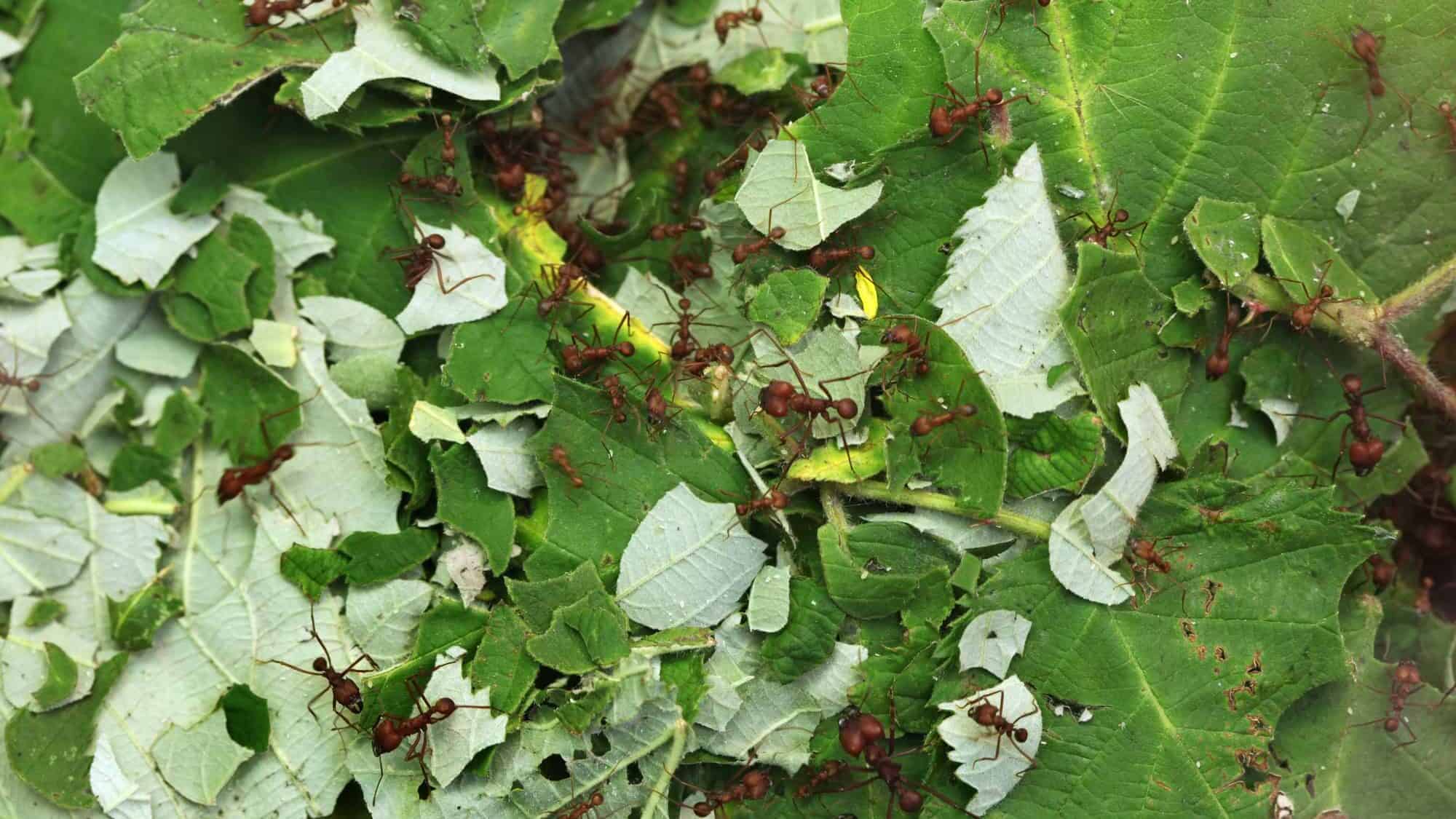
Once leaf fragments reach the underground chambers, the real agricultural work begins. The smallest worker ants, measuring just a few millimeters in length, take over the processing. These tiny farmers first clean the leaf fragments by licking them to remove surface contaminants like bacteria or competing fungal spores. Then, they use their mandibles to cut the leaves into even smaller pieces, creating a fine mulch. This mechanical processing increases the surface area of the leaf material, making it easier for the fungus to access the nutrients locked inside the plant cell walls. The processed material is then incorporated into the existing fungal garden, typically added to the top layer.
Perhaps most remarkably, the ants don’t stop at mechanical processing. They also chemically prepare the leaf material by applying fecal droplets containing digestive enzymes that begin breaking down the tough plant materials. These enzymes help soften the leaves and begin the digestion process that the fungus will continue. Additionally, the ants’ fecal droplets contain beneficial bacteria that assist in breaking down plant toxins and secondary compounds that might otherwise harm the fungal crop. This sophisticated pre-processing demonstrates how leafcutter ants have evolved to overcome one of the major challenges of using fresh plant material—the presence of defensive compounds that plants produce specifically to discourage herbivores. Through this multi-step preparation process, the ants effectively transform toxic leaves into an ideal growing medium for their fungal crop.
The Role of Queen and Colony in Fungal Propagation
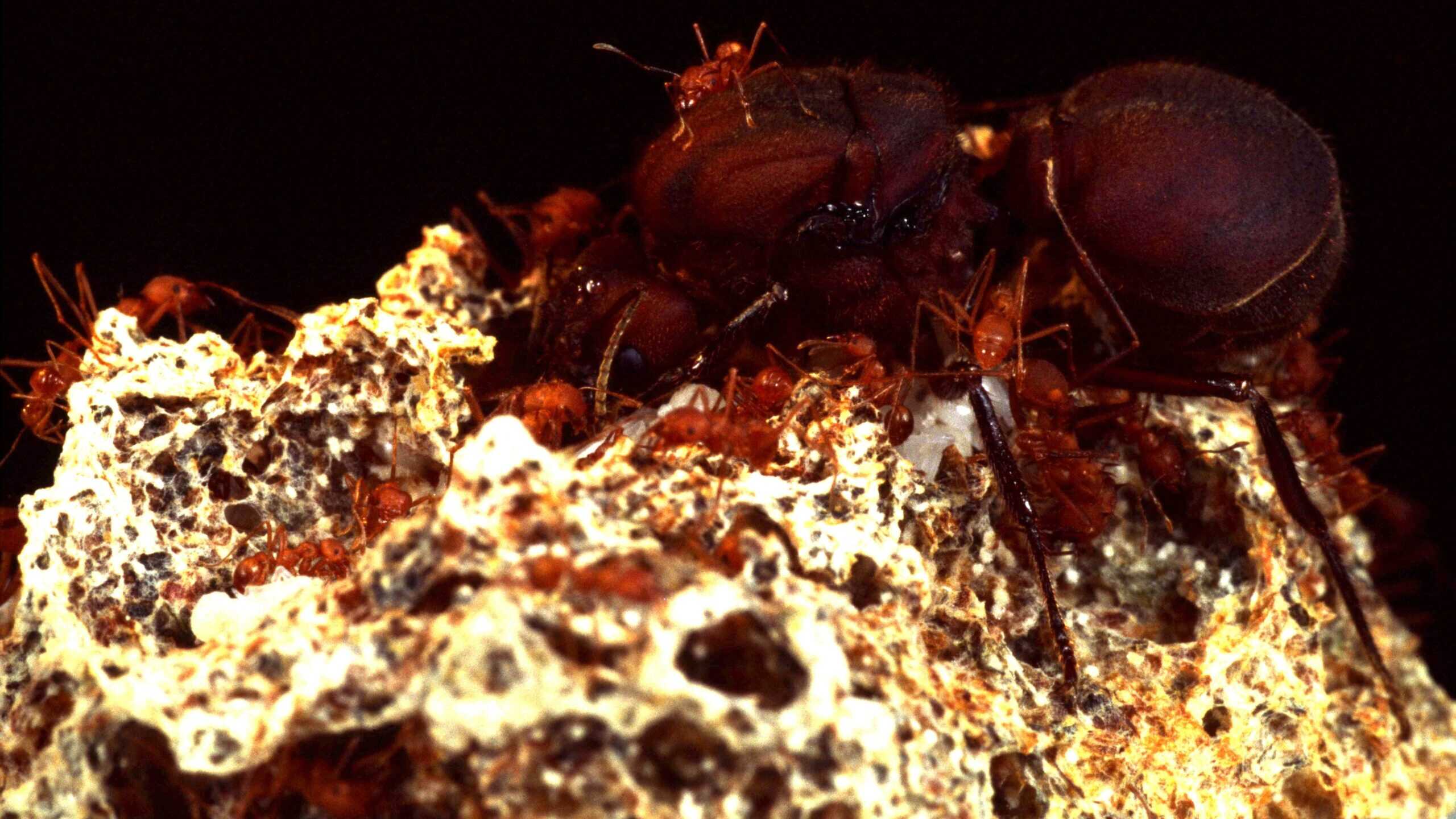
The responsibility for maintaining the precious fungal culture across generations falls to the leafcutter queen. When a virgin queen prepares for her nuptial flight, she takes a small piece of the fungal garden from her maternal nest and stores it in a specialized pocket in her mouth called a infrabuccal pocket. After mating high in the air with several males, she descends to the ground, sheds her wings, and begins digging a new chamber where she will start her colony. Once the chamber is complete, she regurgitates the fungal sample and nurtures it with her own metabolic waste until it begins to grow. This remarkable process ensures the continuity of the specific fungal strain and represents one of the most sophisticated examples of vertical transmission of symbiotic partners in the natural world.
The queen’s initial investment in the fungal garden is substantial. She not only provides the starter culture but also fertilizes it with secretions from her own body and tends it until it becomes established. During this founding period, which can last several weeks, the queen does not leave her chamber or consume any food except for some of her own eggs and the developing fungus. Once the first generation of worker ants emerges, they take over garden maintenance, allowing the queen to focus exclusively on egg production. This careful process of fungal transmission ensures that each new colony begins with a healthy, productive fungal strain that has already proven successful in supporting ant colonies. Some studies suggest that the fungal strains cultivated by certain leafcutter species have been passed down this way for millions of years, representing one of the longest continuous agricultural lineages on Earth.
Garden Maintenance and Pest Management
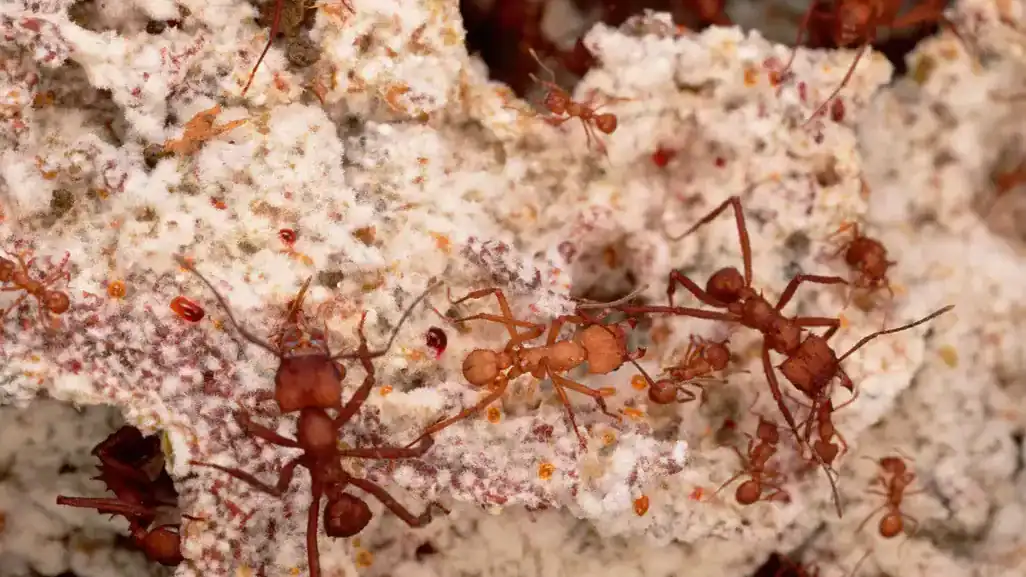
Maintaining a healthy fungal garden requires constant vigilance against pests and pathogens. Worker ants spend much of their time inspecting the garden for any signs of contamination, particularly from competing fungi or parasites. When they detect unwanted organisms, they quickly remove the affected portions to prevent the spread of infection. This selective weeding is remarkably effective—studies have shown that garden chambers remain almost completely free of contamination despite being ideal environments for many types of fungi and bacteria. The ants’ ability to distinguish between their cultivated fungus and potential pathogens relies on sophisticated chemical recognition systems that scientists are still working to fully understand.
Beyond manual removal of contaminants, leafcutter ants have evolved several additional strategies for garden protection. Their bodies harbor specialized exocrine glands that produce antimicrobial compounds which they spread throughout the garden. Additionally, many species maintain symbiotic relationships with antibiotic-producing bacteria, particularly Actinobacteria, which grow on their bodies and help suppress pathogens in the fungal garden. These bacteria, similar to those used to produce many human antibiotics, create a protective shield against the specialized parasites that target the ants’ fungal crop. This multi-layered approach to pest management—combining physical removal, chemical deterrents, and biological control agents—rivals the most sophisticated integrated pest management systems developed by human agriculturalists.
Nutrient Cycling Within the Colony
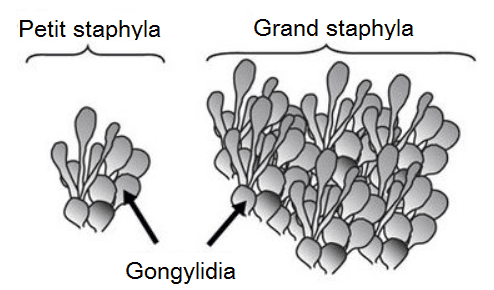
The relationship between leafcutter ants and their fungal crop represents a remarkably efficient system of nutrient cycling. While fresh leaves provide the initial input, the ants have developed sophisticated methods for maximizing nutrient retention within their agricultural system. As the fungus digests the leaf material, it produces the specialized gongylidia structures that the ants harvest. These nutrient-rich structures feed all members of the colony, from the tiniest workers to the queen. The ants then produce waste, which contains partially processed nutrients that are either used to fertilize new sections of the garden or carefully removed to specialized waste chambers where decomposer organisms break them down further.
This closed-loop system is particularly important for nitrogen cycling. Tropical forest soils where many leafcutter species live are often nitrogen-limited, making efficient nitrogen use critical for colony success. Research has shown that leafcutter colonies can retain and recycle up to 90% of the nitrogen brought in through harvested leaves. This recycling ability allows colonies to thrive even in nutrient-poor environments. Additionally, the waste chambers of leafcutter ants create enriched soil patches that can affect the growth patterns of surrounding vegetation, demonstrating how these tiny farmers influence ecosystem-level nutrient cycling. Some plant species have even evolved to preferentially grow near abandoned leafcutter nests to take advantage of these nutrient-rich soil patches.
The Fungus as the Colony’s Digestive System
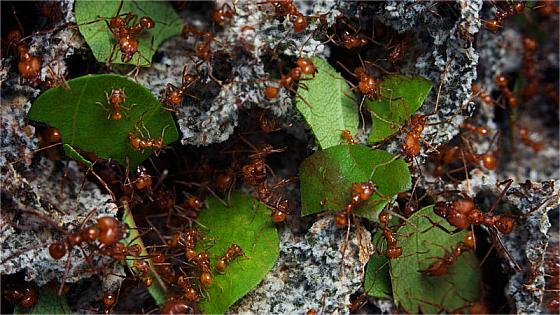
From a biological perspective, the fungal gardens of leafcutter ants function essentially as an externalized digestive system for the colony. Leafcutter ants cannot directly digest the cellulose and other complex compounds found in leaves—they lack the necessary enzymes to break down these plant materials. Instead, they rely on their fungal partner to perform this digestive function. The fungus secretes powerful enzymes that break down cellulose, hemicellulose, and other plant compounds into simpler sugars and nutrients that the ants can absorb. This arrangement is similar to how ruminants like cows use gut bacteria to digest grass, except that the ants have externalized this process into their carefully maintained gardens.
This externalized digestion system provides leafcutter ants with access to nutritional resources that would otherwise be unavailable to them. By essentially “farming” their digestive system, they can exploit the abundant leaf material in tropical forests that few other animals can efficiently utilize. The fungus also detoxifies many plant secondary compounds that would otherwise be harmful to the ants. Some researchers have described this relationship as a form of “agricultural mutualism” where the fungus acts as both crop and digestive symbiont. This dual role makes the relationship between leafcutters and their fungus one of the most intricate symbiotic partnerships known in nature—neither partner can survive without the other, and together they can access resources unavailable to either organism independently.
Threats to the Fungal Gardens

Despite the sophisticated defense systems employed by leafcutter ants, their fungal gardens face several serious threats. The most significant is a specialized parasitic fungus from the genus Escovopsis, which specifically targets the Leucoagaricus fungus cultivated by the ants. This parasite can devastate fungal gardens, consuming the cultivated fungus and potentially causing colony collapse. Escovopsis has co-evolved with the ant-fungus mutualism for millions of years, developing specialized mechanisms to overcome the ants’ defenses. The relationship between leafcutter ants, their fungal crop, and the Escovopsis parasite represents one of nature’s most intricate evolutionary arms races, with each organism constantly developing new strategies and counter-strategies.
Human activities also pose growing threats to leafcutter agriculture. Deforestation reduces the diversity of plant species available for harvesting, potentially limiting the nutritional inputs to fungal gardens. Climate change may disrupt the carefully maintained temperature and humidity conditions that the ants create for their gardens. Additionally, agricultural pesticides can harm both the ants and their microbial symbionts. Some researchers have raised concerns that these anthropogenic pressures could disrupt the delicate balance of this ancient agricultural system that has persisted for millions of years. Conservation efforts increasingly recognize the ecological importance of leafcutter ants, which play vital roles in nutrient cycling, soil aeration, and plant community dynamics throughout their range in the Americas.
The agricultural system developed by leafcutter ants offers valuable insights for human agriculture and ecology. These tiny farmers have solved many of the same challenges that human agriculturalists face, including pest management, soil fertility, crop selection, and sustainable resource use. Their solutions, refined over millions of years of evolution, often rely on biological relationships rather than chemical inputs. For example, their use of antibiotic-producing bacteria to control garden pathogens mirrors modern biological control methods but with greater specificity and fewer side effects than many synthetic pesticides. Some researchers are studying these relationships to develop new approaches to sustainable agriculture.
Beyond agricultural applications, leafcutter ants demonstrate the power of symbiotic relationships in driving evolutionary innovation. The partnership between ants and fungi has allowed both organisms to access ecological niches that would be unavailable to either partner alone. This success story illustrates how cooperation, rather than just competition, can be a powerful force in evolution. As humans face growing challenges in food production and ecological sustainability, the 50-million-year agricultural experiment conducted by leafcutter ants offers both inspiration and practical insights. These remarkable insects remind us that some of the most sophisticated solutions to complex problems may already exist in nature, waiting for us to recognize and learn from them.
- Wild Horses Still Roam the Outer Banks of North Carolina, and Their Origins Are a Mystery - August 20, 2025
- 14 Dangerous Animals That Have Been Spotted in US Backyards - August 20, 2025
- How Leafcutter Ants Use Fungus to Grow Their Own Food - August 20, 2025

